Yokohama
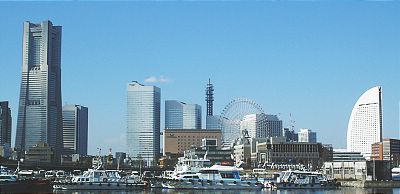
With a population of over three million people, Yokohama is Japan's second largest city. It is located less than 30 minutes south of Tokyo by train, and is the capital city of Kanagawa Prefecture.
Towards the end of the Edo Period (1603-1867), during which Japan isolated herself from the rest of the world, Western nations forced the country to open its ports to foreign trade. In 1859, Yokohama's port became one of the first ports to be openend, and Yokohama quickly grew from a small fishing village into one of Japan's major cities.
Until today, the Yamate residential area retains a Western touch and houses many foreign residents, while Yokohama's Chinatown is one of the world's largest.
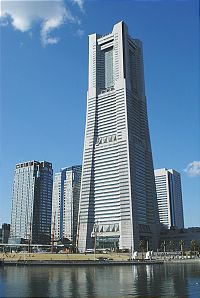
Minato Mirai 21
Minato Mirai literally means "the harbor of the future". It is a futuristic, new city area in Central Yokohama consisting of office and residential space, hotels, shopping centers, restaurants, convention centers and public parks. Development of Minato Mirai was started in 1983, and it is still going on.
The Landmark Tower (296 m) is one of Japan's tallest buildings and the symbol of Minato Mirai 21. It was completed in 1993 and houses many offices, a hotel, restaurants, a shopping center and other community space.
Visitors can access the building's observatory deck, the "Sky Garden" on the 69th floor by means of one of the world's fastest elevators (750 meters per minute). Under good air conditions, Mount Fuji can be seen from the observatory deck.
Pacifico Yokohama is one of the world's largest convention centers, located a few hundred meters from the Landmark Tower. It includes the roundly shaped Yokohama Grand Intercontinental Hotel, which, together with the nearby Ferris Wheel (of the Yokohama Cosmo World amusement park), makes one of Yokohama's most typical sights.
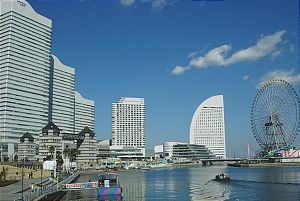
The most centrally located station is Minato Mirai Station on the Minato Mirai Line, two stations from Yokohama Station.
Note that trains on the Minato Mirai Line continue to run on the Tokyu Toyoko Line to Tokyo's Shibuya Station. Limited express trains take about 30 minutes and 440 Yen from Shibuya to Minato Mirai.
Minato Mirai is also conveniently accessed from Sakuragicho Station on the JR Keihin-Tohoku Line (Negishi Line) and Yokohama Subway Line.
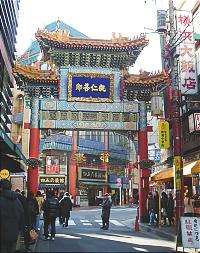
Chinatown
Yokohama Chinatown (Yokohama Chukagai) is Japan's largest chinatown, located in central Yokohama.
Yokohama Chinatown quickly developed, after the port of Yokohama had been one of the first Japanese ports to be opened to foreign trade in 1859. It became the residence of the many Chinese traders who settled down in the city.
Today, a large number of Chinese stores and restaurants can be found in the narrow and colorful streets of Chinatown, while the number of actual residents has been decreasing.
Four colorful gates stand at the entrances to Chinatown, and five more gates can be found within. The Kanteibyo is a gaudily colored temple in the center of Chinatown. Constructed in 1873 by Chinese residents, it is dedicated to the Chinese god of good business and prosperity.
A recent addition to Yokohama Chinatown is Daska, promoting itself as a food theme park. Daska's theme is the Shanghai of the 1920s, and its main attraction are three floors of food stands, some operated by well-known restaurants from China and Japan, selling various Chinese dishes. English language information is rather limited.
Various events and festivals are held in Yokohama Chinatown, such as Chinese New Year around the beginning of February.
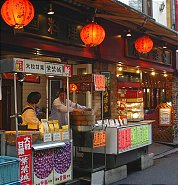 | 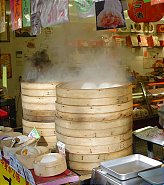 | 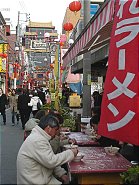 |
| The steets of Chinatown | ||
Yokohama Chinatown is a few steps from Motomachi-Chukagai Station, the terminal station of the Minato Mirai Line, about five minutes from Yokohama Station.
Note that trains on the Minato Mirai Line continue to run on the Tokyu Toyoko Line to Tokyo's Shibuya Station. Limited express trains take about 35 minutes and 460 Yen from Shibuya to Minato Mirai.
Chinatown is also a short walk from Ishikawacho Station on the JR Keihin-Tohoku Line (Negishi Line).
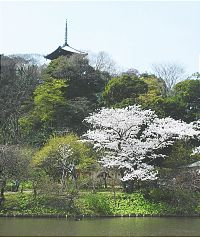
Sankeien
Sankeien is a spacious Japanese style garden in southern Yokohama which exhibits a number of historic buildings from across Japan. There is a pond, small rivers, flowers and wonderful scrolling trails that make you think you are in Kyoto rather than Yokohama.
The garden was built by Hara Sankei and opened to the public in 1904. Among the historic buildings exhibited in the park are an elegant daimyo (feudal lord) residence, several tea houses and the main hall and three storied pagoda of Kyoto's old Tomyoji Temple.
From Yokohama Station (East Exit): About 35 minutes by bus number 8 or 125 to Honmoku Sankeien Mae. From there, Sankeien is another 5 minutes by foot.
From Negishi Station (JR Keihin-Tohoku Line): About 10 minutes by bus number 54, 58, 99, 101 or 108 to Honmoku. From there, Sankeien is another 5-10 minutes by foot.
Ramen Museum
The "Shinyokohama Raumen Museum" is a unique museum about ramen, a very popular Japanese noodle dish which was originally introduced from China.
In a gallery on the first floor, the Ramen Museum presents the history of ramen noodles in Japan, including the big success of instant ramen. It displays the variety of noodles, soups, toppings and bowls used across Japan, and shows how the noodles are made.
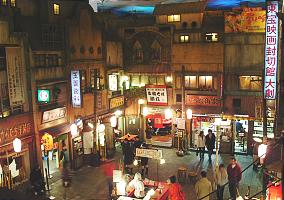
On the two basement floors, visitors can explore a 1:1 replica of some streets and houses of Shitamachi, the old town of Tokyo, of around the year 1958, when the popularity of ramen was rapidly increasing. Nine ramen restaurants can be found there, each featuring a ramen dish from a different region of Japan.
For visitors who wish to try multiple ramen dishes, every store offers "mini ramen", a small portion of the feature dish. Tickets for the meals are purchased at vending machines in front of each stores before entering.
The Ramen Museum is a 5-10 minute walk from Shin-Yokohama Station.
Motomachi and Yamate
After Yokohama's port was opened in 1859, many foreign business people moved to Yokohama. While Chinese traders settled down in Chinatown, Western business people favored the Yamate area just across the Horikawa River for their residence.
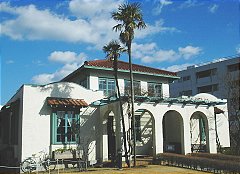 | 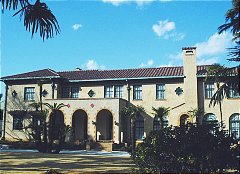 |
The Yamate area is a hill close to the harbor. It remains a calm residential area with a foreign touch. The International School, the Foreigners' Cemetery, the Italian Garden and the former mansions of Western business people can be found in the area today.
The Harbor View Park is a public park located on top of the Yamate hill, offering a nice view of the Bay Bridge. It is a popular dating spot among the Yokohama-ites.
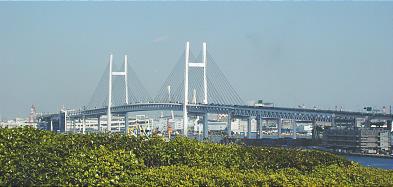
Motomachi lies at the foot of the Yamate hill. It features the very popular and fashionable Motomachi Shopping Street which used to be a shopping area for the foreign community of Yamate. It still retains a certain European touch.
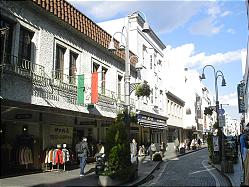
The Motomachi and Yamate districts are a short walk from Motomachi-Chukagai Station, the terminal station of the Minato Mirai Line, about five minutes from Yokohama Station.
Note that trains on the Minato Mirai Line continue to run on the Tokyu Toyoko Line to Tokyo's Shibuya Station. Limited express trains take about 35 minutes and 460 Yen from Shibuya to Minato Mirai.
The closest JR station is Ishikawacho Station on the JR Keihin-Tohoku Line (Negishi Line).
Waterfront Promenade
The Yamashita Rinkosen Promenade is a nice waterfront promenade connecting Minato Mirai 21 with Yamashita Park. It used to be the route of the Yamashita Rinko Line, a harbor freight railway line.
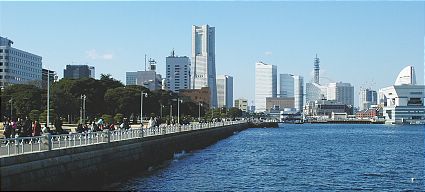
The promenade starts in the futuristic Minato Mirai 21 district. From there it leads along the waterfront, passing the Red Brick Warehouses, which have recently been transformed into a pleasant shopping and community center. The promenade then passes the architecturally remarkable New Yokohama International Port Terminal, where passenger liners arrive and depart.
The promenade finally leads into Yamashita Park, a public park at the foot of the Yamate hill. The Marine Tower, a 106 meter tall lighthouse is located nearby. The Hikawa Maru, a passenger ship which served on the Yokohama-Vancouver/Seattle and other routes from 1930 to 1960, is docked in front of Yamashita Park, and is open to the public (entrance fee applies).
The promenade starts at Minato Mirai 21, which is accessed from Minato Mirai Station on the Minato Mirai Line or Sakuragicho Station on the JR Keihin-Tohoku Line (Negishi Line) and Yokohama Subway Line. At the other end of the promenade, Yamashita Park is a short walk from Motomachi-Chukagai Station on the Minato Mirai Line.
Note that trains on the Minato Mirai Line continue to run on the Tokyu Toyoko Line to Tokyo's Shibuya Station. Limited express trains take about 30 minutes and 440 Yen from Shibuya to Minato Mirai and 35 minutes and 460 Yen to Motomachi-Chukagai Station.